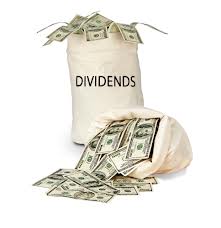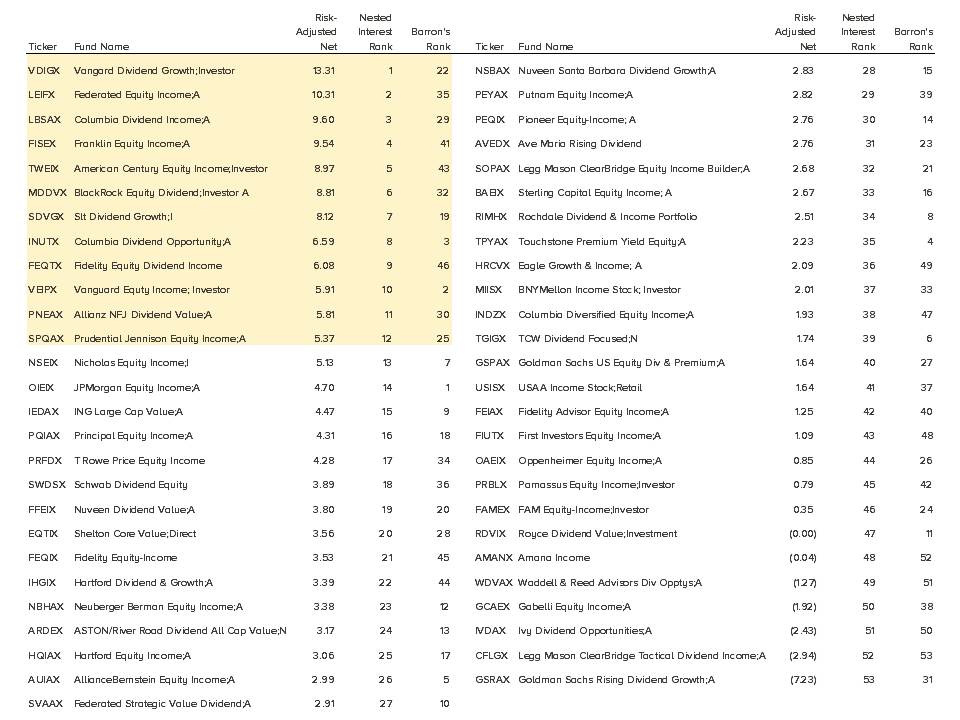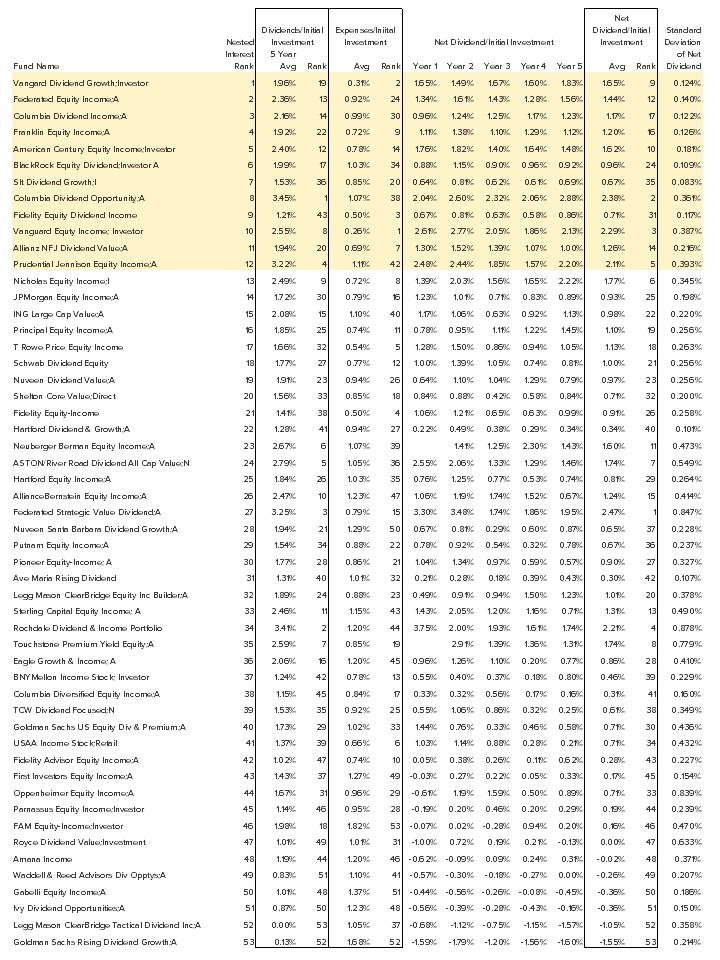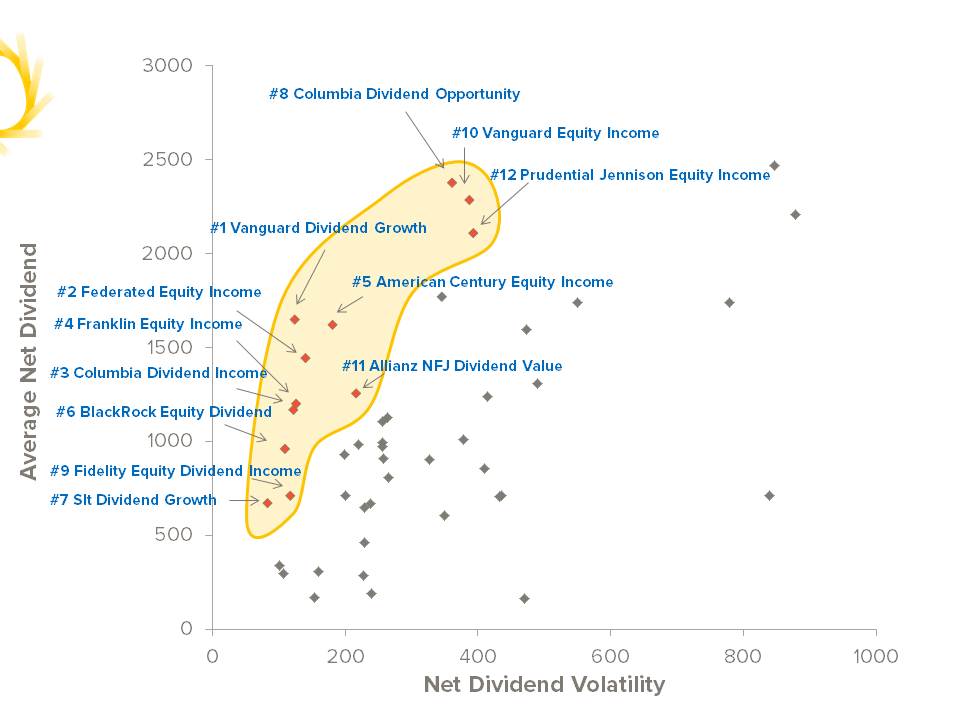Barron’s Top Dividend Funds…Revisited

If you have read some of my other blogs, you know I am not a big fan of dividend-oriented investing for a number of reasons. However, income starved investors that are feeling the pain of today’s zero interest rate environment are seeking alternative sources of income, and many are fleeing to dividend funds for this purpose.
With this backdrop, it was disappointing to read this past week’s edition of Barron’s, which featured an article that ranked top dividend funds (“Top Dividend Funds” appearing in the November 5, 2012 edition of Barron’s). What was puzzling to me, and what prompted me to write this blog, was that Barron’s ranked the dividend funds based upon their 3 year total return, which includes dividends and appreciation in share price. While this measure is appropriate if your investment goal is focused on long term growth, it is not appropriate if your objective is to provide a steady paycheck. And, if it is growth that you are most concerned about, why invest in dividend-rich funds?
Over the last few days, I did some research on the 53 funds included in Barron’s study and used an alternative measure to rank the performance of these funds that would be more appropriate for an income-oriented investor. Here are the results, alongside Barron’s rankings:
Click on Image to Enlarge
How I Ranked The Dividend Funds
An income-oriented investor is more concerned about the level and stability of the income that is provided by their investments, and relatively less concerned about the opportunity for their investment to appreciate in value (income-oriented investors typically prefer to leave their principal intact while living off of the income produced by their investments). The measure that I used to rank the dividend funds incorporated the following historical performance measure over the past five year period (as available in each fund’s current prospectus):
Average Dividend: We calculated the dividend (using the per unit net investment income provided in each fund’s prospectus) for each of the five years. Everything else being the same, the more dividend income that can be produced, the better.
Average Expense: We calculated the each year’s expense incurred by the fund (and charged against the net asset value of the fund). Expenses create a headwind for income investors, reducing the amount of available income that may be drawn down without tapping into principal. A fund that generates a dividend yield of 4% at an expense of 2% of assets (net income = 4%-2% =2%) is less attractive than a fund that can generate a dividend yield of 3% and expenses of 0.5% (net income = 3%-0.5% = 2.5%).
Net Dividend Volatility: We calculated the standard deviation the “net dividend”, which we defined as dividend less expenses, over the five year period. Everything else the same, the less volatile (or the more stable) that net dividends are, the better.
So, an income-oriented investor seeks high average dividends, low expenses, and low net dividend volatility.
These measures were combined into a single measure that I refer to as the Risk-Adjusted Net Dividend Ratio, as follows:
Risk-Adjusted Net Dividend Ratio =
(Average Dividend – Average Expense)/Net Dividend Volatility
As dividend yields increase, expenses decrease, and volatility decreases this ratio will increase. For those of you that are familiar with investment management, you may recognize a similarity to the Sharpe Ratio, adapted to dividend performance.
Reviewing the Results
Historical performance of any investment does not necessarily indicate anything about future performance, so any analysis done on historical performance must be done keeping this basic fact in mind.
Looking at performance through this lens leads to some dramatically different conclusions regarding relative fund performance. Many funds that were ranked low by Barron’s look quite good for income investors. Federated’s Equity Income Fund, Franklin’s Equity Income Fund, and American Century’s Equity Income Fund were ranked 35th, 41st, and 43rd, respectively, by Barron’s, but all appear in our top five ranked funds based on their Risk-Adjusted Net Dividend Ratio. Conversely, some funds that were ranked high by Barron’s did not fare as well under this alternative measure; Touchstone’s Premium Yield Equity Fund, TCW’s Dividend Focused Fund, and Royce’s Dividend Value Fund were ranked 3rd , 6th, and 11th by Barron’s but only a achieved a ranking of 35th , 38th, and 47th on our list.
To better understand what is driving these results, here is more detail on the five years of net dividends for each fund, their average, and their volatility for a given investment at the beginning of the five year period:
Click on Image to Enlarge
Observations
1. High Dividend Yields Can Be Deceiving
Many of the funds with the highest average net dividends were not at the top of our list because of their high volatility. Federated’s Stategic Value Dividend Fund and Rochdale’s Dividend and Income Portfolio, for example, were among the highest net dividend performing funds on the list, but only came in at 27th and 34rd on our list, respectively, because the volatility of their net dividends. To further illustrate this, over the five year historical period we examined the range of annual net dividends received on a $100,000 initial investment at the beginning of the five year period would have been from $1,740 on the low end up to $3,479 on the high end for the Federated Strategic Value Dividend Fund, about a 100% difference. Compare this to the Columbia Dividend Opportunity Fund (ranked 11th on our list), which produced a similar average net dividend over this five year historical period, but with much narrower range and volatility (the lowest net dividend was $2,037, and the highest $2,876).
2. Fees Can Make a Big Difference
The correlation of fees to our rankings is a bit mixed. While you do see some of the lower expense funds appearing in the upper part of our rankings (see the Vanguard Dividend Growth Fund, Fidelity Equity Dividend Income Fund, and Vanguard Equity Income Fund), funds with modestly higher expense levels also performed well, which may suggest that more active management may create an economic benefit. However, funds with the largest expenses had relatively low rankings. Looking at the detailed data, we can see that some funds were able to move up quite a bit in the rankings because of low expenses; for example, Fidelity’s Equity Dividend Income fund ranked 43rd in average dividend, but jumped up to 31st place when expenses were taken into account in the net dividend calculation. At the same time, some funds were negatively affected by expenses; the FAM Equity-Income fund was ranked 18th in average dividend, but dropped all the way to 46th place when its expenses were factored into the net dividend calculation. In short, there is no clear cut correlation between expenses and Risk-Adjusted Net Dividend Ratio results, but it has made a big difference for certain funds.
3. Many Inefficient Funds
There are many funds on this list that generate much lower net dividends and more volatility than their competitors – not a good combination! To better illustrate this, the graph below plots each fund against the net dividend volatility (X axis) and average net dividend (Y axis). Ideally, we want to have a fund with low net dividend volatility and high average net dividend, so we prefer those funds in the upper left part of the chart and avoid those closer to the bottom right side of the chart:
Click on Image to Enlarge
We have highlighted the top twelve funds from our rankings, and as you can see they are in the “efficient frontier” region highlighted in yellow toward the upper left portion of the chart, making them the most preferable of the funds in the rankings. Interestingly, many of the remaining funds are far removed from this efficient frontier, suggesting that they are not delivering attractive levels of net dividend for the risk that the investor is bearing.
This chart also illustrates another important point – that dividend fund performance cannot succinctly be summarized in a single measure. In particular, the twelve top dividend each deliver different combinations of net dividend income and volatility; those more sensitive to volatility would may prefer the Slt Dividend Growth fund (ranked 7th on our list) while those willing to bear more volatility in the hope of receiving higher levels of net dividend income may gravitate toward the Columbia Dividend Opportunity fund (ranked 8th on our list). One is not necessarily categorically better than the others; one offers the benefit of lower risk while the other offers the opportunity for more income.
Concluding Thoughts
As I mentioned at the onset, I am not a big believer in dividend-oriented investing as a primary way of generating retirement income. However, if you are considering doing this it is important to measure performance in a way that is best aligned with your concerns as an investor. For the conservative, income-oriented investor this means moving away from a single measure exclusively focused on total return (as Barron’s did), and instead more thoughtfully examining the level of net dividend income produced and its volatility.
Posted by
John Bevacqua on November 8, 2012
 Follow us on Twitter
Follow us on Twitter Follow us on Facebook
Follow us on Facebook

